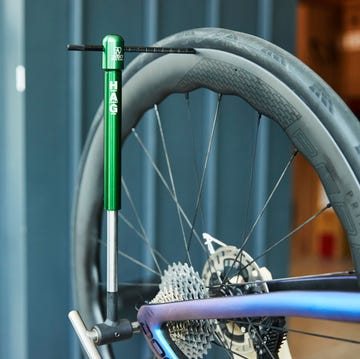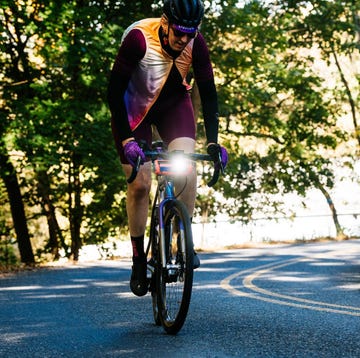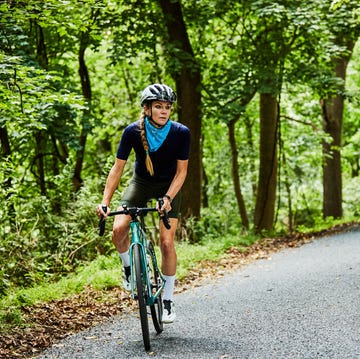If you’ve never taken your hands off your handlebars midride to shake out numbness or a pins and needles sensation, are you even a cyclist? Although we don’t have the data to know exactly how common hand numbness is in cyclists, according to the experts we spoke to, it’s far from unusual.
The good news: Hand numbness can often be alleviated by adjusting your bike fit. Keep reading to find out why your hands are going numb during your rides and how you can adjust your fit to solve the problem.
Why Your Hands Go Numb During a Ride
The most common reason cyclists experience hand numbness is that they’re putting too much pressure on the front end of the bike, says bike fit pro and physical therapist Kur Sohn of Velofit Physical Therapy. “When you put too much pressure on the blood vessels and nerves that go into your hands, it can cut off circulation,” he explains.
Inadequate blood flow can lead to paresthesia, or the numbness, burning, tingling, or “asleep” feeling that affects your extremities when there’s too much pressure on one body part for too long.
“If you’re not able to take your hands off the handlebars [when riding] at a moderate intensity, without your chest falling forward, you have too much weight on your hands,” says doctor of physical therapy and certified bike fitter Tim Tracy.
Ideally, you should follow what Sohn calls “the 80/20 rule,” keeping 80 percent of your weight in the saddle and 20 percent over the front end of your bike.
Neck issues can also lead to hand numbness for cyclists. If you have a forward head posture (which many of us do, especially those of us who work at a computer), spending hours on the bike only exacerbates it. And forward head posture goes hand-in-hand with rounded shoulders, which compresses your brachial plexus, the network of nerves that stem from the neck and upper torso sections of the spine and controls movement and sensation at the hand, arm, and shoulder.
While intermittent hand numbness is unlikely to have any long-term debilitating effects, it’s not something you should ignore, says Tracy. Compromised hand sensation can interfere with your bike handling and ability to control the bike, including your brakes, which presents some serious safety risks.
And of course, a comfortable ride is a more fun ride. “If people are comfortable, they’re going to perform better and they’re going to have a more enjoyable experience,” says Tracy.
Bike Fit Issues That Could Cause Hand Numbness
If you’re dealing with hand numbness during your rides, it might be time to reassess your bike fit. Here are some of the most common fit-related problems that lead to hand numbness in cyclists.
The best way to handle these issues? Go see a professional fitter who can evaluate the entire fit of your bike. But if you can’t get to one, we also offer tips for making adjustments.
1. Saddle Position
Saddle position is foundational to your bike fit, so make sure it’s the first thing you look at if you’re having hand numbness.
When it comes to saddle positioning, the two biggest contributors to hand numbness tend to be fore/aft adjustment and saddle tilt, says Sohn. A seat that’s too far forward puts more pressure on your hands, whereas a seat that’s too far back can force you to lock out your wrists and elbows, which contributes to forward head posture and compression through the brachial plexus.
To find a saddle fore/aft that works for you, Sohn suggests using the Knee Over Spindle (KOPS) method. Start by hopping on your saddle and positioning your pedals at 9 and 3 o’clock. Next, drop a plumbline from your front kneecap. It should intersect with your pedal spindle (the middle of your pedal). This might not get you in the perfect position, but it’s generally a good baseline.
If your saddle fore/aft looks good, don’t be surprised if the angle is the problem. “Saddle tilt is one of the biggest things I have to adjust,” says Sohn. If the front of your saddle is pointing downward (even slightly!), gravity will force you to slide toward your hands, which will create pressure that leads to numbness.
To adjust your saddle tilt, start by using a level or a level app on your phone to put it in a neutral position. But know that for most cyclists, this is just a jumping off point. “You can start there, but a lot of people can’t tolerate a perfectly level saddle. It really depends on your mobility, core stability, and your anatomy,” says Sohn.
While Sohn might give a cyclist up to 2 degrees of downward tilt (where the nose is tilted slightly downward), he never positions the saddle in an upward tilt. “There are too many negative effects to that as it rolls your pelvis into a posterior tilt and puts your perineal area exposed to more pressure at the nose,” he explains.
If you do some adjustments but keep having issues, it’s probably time to see a pro, even if just for the saddle.
2. Handlebar Reach
Handlebar reach can also contribute to hand numbness during your rides. If you have to stretch your arms out to reach your handlebars, you may be riding with your elbows locked out, which can lead to a forward head posture that limits circulation through your brachial plexus. If you’re too stretched out, assuming your saddle fore/aft is dialed in, you’ll probably benefit from a shorter stem.
On the other hand, handlebars positioned too close to your body can force you to put too much pressure on your upper body to hold yourself upright. To avoid a shortened reach, keep your elbows flexed no more than 20 degrees, says Tracy. If you need more than 20 degrees of elbow flexion, if your seat fore/aft is already well-positioned, you probably need to try a longer stem.
3. Handlebar Height
The wrong handlebar height can also cause hand numbness. It can be tempting to lower your handlebars to achieve a more aerodynamic (and presumably faster) position. However, if you lack the core strength and flexibility to comfortably maintain that position, you risk putting excessive pressure on your hands to support your bodyweight, and that pressure can lead to numbness, says Sohn.
Position your handlebars too high, on the other hand, and you can shorten your reach to the point where you create other problems. In this scenario, it’s common for cyclists to attempt to achieve balance between the front and back of your bike by pushing against the handlebars. “From there, it’ll translate into their shoulder blades and actually propel their head forward and actually put more pressure on their hands,” says Sohn.
To find the right handlebar height for you, start by adjusting them so that you can easily operate your brakes with a slight bend at your elbow. With your hands on the hoods or wrapped around the hook portion of the drops (i.e. the curved part), your wrists should be in a comfortable position, where they’re neither turning toward the thumb side or the pinky side.
4. Handlebar Angle
Sometimes hand numbness is due not to excessive weight through your hands but to an awkward wrist angle. The fix? Adjust your handlebar angle.
When you’re using drop bars, your wrists and hands should optimally be in a neutral grip. In other words, when you’re not in the drops or gripping the top of your handlebar, your palms should rest against the outside of your hoods, with your thumbs curled around the tops of your hoods.
However, many bikes come with relatively flat hoods, which can put your wrist into ulnar deviation, or force your wrist to bend toward the pinky side, says Tracy. That position can result in ulnar nerve compression, which leads to numbness and discomfort in your hands, particularly in your ring and pinky fingers. If this is the problem, you can solve it by rotating your handlebars slightly downward (i.e. turning your handlebars so that the front of your hoods turn just a bit toward the ground).
By the same token, if your handlebars are rotated too far upward, you’ll find your wrists in radial deviation, or bending upward toward the thumb side. In that case, you might experience numbness and discomfort associated with radial nerve compression. If this is the issue, you’ll feel it along the thumb side of the back of your wrist and hand.
Whatever you do, make one change at a time and go for a ride to see how it feels before you adjust anything else. While there is a science to bike fit, finding your just right “Goldilocks” fit is often a matter of trial and error, says Tracy.

Pam Moore is an occupational therapist-turned-intuitive eating coach, certified personal trainer, and award-winning freelance writer with bylines in outlets including The Washington Post, Time, SELF, Outside, Runner's World, and others. Listen to her podcast, Real Fit, or subscribe to her newsletter, Real Nourished, at













